Shanghai International Circuit
 | |
| Location | Jiading, Shanghai, China |
|---|---|
| Time zone | UTC+08:00 |
| Coordinates | 31°20′20″N 121°13′11″E / 31.33889°N 121.21972°ECoordinates: 31°20′20″N 121°13′11″E / 31.33889°N 121.21972°E |
| Capacity | 200,000[1] |
| FIA Grade | 1 |
| Owner |
|
| Operator | Shanghai International Circuit Co., Ltd. |
| Opened | 2004 |
| Construction cost | ¥2.6 billion ($450 million, €370 million) |
| Architect | Hermann Tilke |
| Major events |
Formula One Chinese Grand Prix MotoGP Chinese motorcycle Grand Prix WEC 6 Hours of Shanghai WTCC Race of China V8 Supercars |
| Length | 5.451 km (3.388 mi) |
| Turns | 16 |
| Lap record |
1:32.238 ( |
The Shanghai International Circuit (simplified Chinese: 上海国际赛车场; traditional Chinese: 上海國際賽車場; pinyin: Shànghǎi Guójì Sàichēchǎng) is a motorsport race track, situated in the Jiading, Shanghai, People's Republic of China. The circuit is best known as the venue for the annual Formula 1 Chinese Grand Prix, which it first hosted in 2004.
History
Costing approximately 2.6 billion yuan[2] ($450 million), the circuit was financed by a government-funded joint-venture company, consisting of the Shanghai Jiushi Group, Shanghai National Property Management Co Ltd, and Shanghai Jia'an Investment and Development Co Ltd. Architectural and design experts began planning and visiting the site between April and May 2003, and the area was transformed from swampland to international racetrack within 18 months with a team of 3000 engineers working around the clock.
Other events held at the circuit include a round of the MotoGP world championship, the Australian-based V8 Supercar championship in 2005, attracting crowds of over 250,000 spectators, and also the final round of the A1 Grand Prix in 2006/2007.
The 2008 MotoGP race was the last one on this circuit, as the FIM didn't select the racetrack for the provisional calendar of 2009. This is due to overcrowding problems in the circuit.[3]
In September 2007, former manager of the circuit Yu Zhifei [4] was convicted of embezzlement as part of a corruption scandal in Shanghai which resulted in the dismissal of several senior Chinese Communist Party officials.[5]
Partly due to location of the circuit, areas around turns 1, 8 and 14 have been sinking, and therefore the circuit had to be inspected before the 2011 event took place.[6]
The Chinese Grand Prix attracted 260,000 spectators in its inaugural year in 2004 with a slight 10,000 increase in 2005, but attendance has since declined with 155,000 attending in 2010. On Feb 18, 2011, Reuters reported words from the Chinese Grand Prix organizers said Shanghai has extended the deal to host the Chinese Grand Prix to 2018 despite falling attendance. Reuters reported words from Yiping Chen, deputy director of the Shanghai Sports Bureau, suggested the situation can improve in the following years by lowering the ticket cost. Reuters reported prices for prime seats range would decrease from 3,580-3,980 yuan in 2010 to 1,980-3,280 yuan in 2011.[7] On the same day, AFP reported that the Shanghai City government will keep open a subway line to the race track to boost spectator numbers from April 15–17, 2011.[8]
The February 18, 2011 Reuters news also reported words from Wen Zhao, vice-mayor of Shanghai, suggested F1 is a calling card for Shanghai and she is confident that the success of the event in the years ahead.[7]
Layout
In common with many other new Formula One circuits, it was designed by Hermann Tilke, and also features his trademark track feature: a long back straight followed by a hairpin turn. Current-generation F1 cars can easily surpass 300 km/h (186 mph) on the long straight between corners 13 and 14.[9] The track layout was inspired from the Chinese character shang (上) the first character in the name of the city Shanghai, meaning "above" or "ascend".[10] One lap lasts 5.5 kilometres (3.4 mi). The whole circuit plus seating areas and other areas for spectators, covers a total area of 5.3 km².
A lap in a Formula One car
Turns 1 and 2 make up a very long right-hand curve which leads immediately into turns 3 and 4, a very long left-hand curve. One and two are far more difficult - a lift on entry followed by various taps of the throttle and brakes are needed so the car maintains balance throughout. It also becomes blind towards the middle of the corner.[11] Three and four are nowhere near as difficult but a good exit is needed to gain speed down the following straight and through turn 5. The complex of turns 1-4 makes up the first of two "snails" on the circuit, the other being turns 11-13.[12] Turn 6 is a second gear, right-handed hairpin with plentiful run-off. Turns 7 and 8 make up a high speed chicane - the left-right complex sees a constant G-force of 3[11] and a minimum speed of about 100 mph. Turns 9 and 10 immediately follow - two slow left-handers which require a good exit to gain speed down the next straight. Turns 11 and 12 effectively make up a slow left-right chicane where the use of kerbs are important but traction is low. Turn 13 is a very long right-hander which becomes less and less tight, and a very good exit is important as the longest straight currently in Formula One follows. At 1170m, it is the equivalent to 11 football pitches laid end to end, or the same length as three and a half of the world's biggest aircraft carriers[13] Turn 14 is a hairpin at the end of the straight - the second gear corner is a prime overtaking spot as DRS is available in the run up to the corner. Turn 16 is the last corner - a fourth-gear[11] left-hander which requires a quick tap on the brakes - braking early can be more effective as you can then carry more speed through the corner and then down the pit straight.
The total length of the circuit is 5.451 km (3.387 mi), which is about average for a Formula One circuit. The lap record was set by Ferrari's Michael Schumacher in 2004. He completed one lap of the circuit in 1:32.238.
Records
Gallery
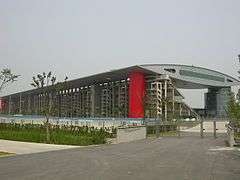 Exterior of main grandstand
Exterior of main grandstand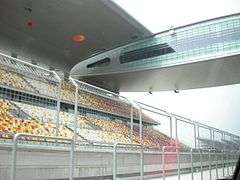 Main grandstand
Main grandstand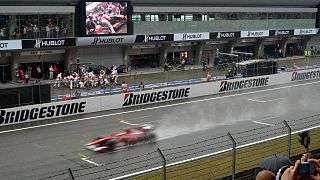 View from the main grandstand
View from the main grandstand Covered grandstand H & K
Covered grandstand H & K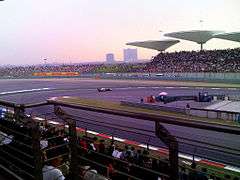 Grandstand H & K
Grandstand H & K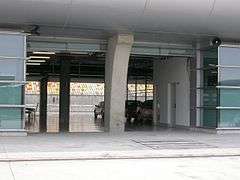 Pit
Pit
References
- ↑ "Shanghai International Circuit". worldofstadiums.com. Retrieved 24 June 2016.
- ↑ "F1 preview on track". chinadaily.com.cn. Retrieved 24 June 2016.
- ↑ FIM announce provisional 2009 MotoGP calendar MotoGP.com, retrieved on July 25, 2008
- ↑ Chinese boss fired Forumula1.net, retrieved on October 10, 2007
- ↑ "Chinese F1 boss found guilty". GPUpdate.net. GPUpdate. 19 September 2007. Retrieved 30 January 2011.
- ↑ "Shanghai circuit gets sinking feeling". Yahoo Eurosport. 25 January 2011. Retrieved 7 February 2011.
- 1 2 "Shanghai to host F1 for seven more years - city officials". reuters.com. 18 February 2011. Retrieved 21 February 2011.
- ↑ "Motorsport: Shanghai to keep GP for seven more years". nzherald.co.nz. 18 February 2011. Retrieved 21 February 2011.
- ↑ Shanghai International Circuit Facts & Figures Forumula1.net, retrieved on October 10, 2007
- ↑ "Chinese Grand Prix Preview". Fédération Internationale de l'Automobile. 2009-04-13. Retrieved 2009-04-16.
- 1 2 3 >"Shanghai International Circuit guide". F1 Fanatic. Retrieved December 21, 2012.
- ↑ RedBull.com (4 May 2012). "Circuit Guide: Shanghai International Circuit". Red Bull Motorsports. Retrieved 31 October 2015.
- ↑ "Straight-line power - the engine in Shanghai". F1™ - The Official Formula One Website. Retrieved December 21, 2012.
- ↑ 2005 V8 Supercar Shanghai round results
External links
| Wikimedia Commons has media related to Shanghai International Circuit. |
- Shanghai International Circuit
- Shanghai International Circuit | JUSSEVENT
- Shanghai International Circuit at Official Formula 1 website
- Map and circuit history at RacingCircuits.info
- Ciro Pabón's Racetracks 3D views and virtual laps of all F1 circuits, including this one, via Google Earth
- Shanghai International Circuit on Google Maps (Current Formula 1 Tracks)